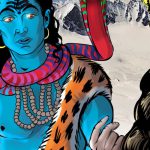Rupert Bear
Regions: UK

Rupert Bear is a comic series that has appeared in the British newspaper, The Daily Express, since November 8, 1920. Although originally published in England and intended for an audience of British children, Rupert comics have been published in the Netherlands since the 1930s and have gained additional international interest since then.
The original idea for Rupert Bear came from the artist Mary Tourtel (1874-1948), the first illustrator of the comic series. Rupert stories follow the adventures of an anthropomorphic cast interspersed with a handful of human characters, with a polite yet bold bear as the title character. The kind, intelligent, and curious Rupert resides with his mother and father in the fictional town of Nutwood. Rupert stories typically begin and end with Rupert at home; in the meantime, a simple task or chore often develops into a magical escapade. Usually accompanied by some of his friends from Nutwood (Bill Badger, Edward Trunk, Tigerlily, and many more), Rupert has adventures riddled with elements of magic and mythology and often involving travel to distant lands, both real and imagined.
In 1935, Tourtel’s eye sight began to deteriorate, leading to Alfred Bestall being instated as the writer and illustrator. After Bestall took over, Rupert’s appearance changed from a round-featured brown bear to a more stream-lined bear with white fur. Some suggest that the change in color choice reflects the intention to save money for printing costs by making the main character devoid of color. In 1965 Alex Cubie took over as the illustrator and the stories were written by Freddie Chaplain. Beginning in 1978, Rupert stories were written and illustrated by John Harrold, and in 2008, John Trotter took over as illustrator and storywriter. While Rupert’s artists have changed and many fans have expressed concern about alterations to his iconic appearance; however, Rupert’s iconic bright red sweater and yellow plaid pants and scarf have remained the same since his first appearance.
Tourtel established a popular character with great staying power with the celebrated bear who has seen numerous incarnations since the 1920s. Tourtel’s original comic stories and character were so popular that the first book adaptation, The Adventures of the Little Lost Bear, was published in 1921, less than a year after the Rupert comics had been introduced. Rupert Bear stories also appeared in annuals—collections of the newspaper comics which had appeared over the preceding twelve months—beginning in 1936. The comic characters were translated to television in the 1970s, using marionettes to tell the stories. Rupert, based on the original characters, setting, and story-telling of the Rupert Bear comic is a cartoon series that was originally produced in France and Canada, and airs in syndication on the educational channel, Qubo. Rupert has been most recently reimagined for contemporary children’s audiences in computer animation.
Rupert boasts a longer-held reputation than the famous Winnie the Pooh or Paddington and has built a multi-generational, international fan-base. The little bear in the sweater and scarf, whether white or light brown, has made an indelible mark on popular culture, even boasting musical stories like “Rupert and the Frog Song,” created by the world famous musician, Paul McCartney, in 1984.
— Katelynd L. Gibbons
Further Reading
- The Official Rupert Bear Society. “The Followers of Rupert.” Last modified 2015. Accessed March 30, 2015. Official Rupert Bear Society Website. http://rupertbear.co.uk/catalogue.php.
- Bott, Caroline G. The Life and Works of Alfred Bestall: Illustrator of Rupert Bear. London: Bloomsbury UK, 2004.
- Radcliffe, Mark. “My Lifelong Love of Rupert Bear.” The Telegraph, October 20, 2011. Accessed April 2, 2015. http://www.telegraph.co.uk/culture/tvandradio/8838833/Mark-Radcliffe-My-lifelong-love-of-Rupert-Bear.html.
- Robinson, Ian. The Rupert Companion: A History of Rupert Bear. London: Eggmont Books, 2010.


